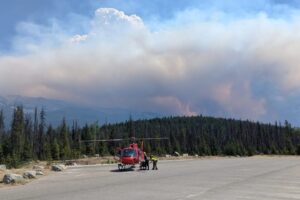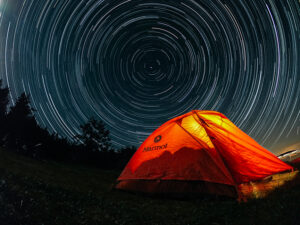I’ve tried to avoid big packs on multi-week journeys by manhauling sleds in winter and sea kayaking in summer. Backpacking is my least favorite form of wilderness travel because the packs are never under 40kg. But for some routes, there is no other solution. In these cases, a backpack designed to carry a heavy load makes the experience as bearable as possible.
Best Expedition Backpacks: Heavy Haulers Tested
At ExplorersWeb, we have a lot of experience with really heavy packs. And while we appreciate the many duffels, sleds, and other methods of hauling heavy loads, sometimes you just need a good, heavy hauling backpack. Below, we jump into the top expedition-worthy backpacks we tested this year. If you skip down the page, I explain the many uses for expedition backpacks.
Norrona Recon 125L Synkroflex, $700

Best For: Load-bearing superiority of an external frame mixed with a snug fit
- Load-bearing capability (out of 5): 5
- Volume: 125 Litres (7600 cu in)
- Weight: 4.7kg (10 lbs 6 oz)
- Pros: Huge volume, external frame excels at load bearing
- Cons: Heaviest, most expensive
- Sustainability Features: More than 50% of the synthetic fibers are recycled thanks in part to Econyl regenerated nylon yarn, PFC-free DWR
Even beside its mammoth brethren, this backpack — the Norrona Recon 125L Synkroflex ($700) — dominates in size. It looks like it was designed for a race of giants. The Norse god Thor would have used it to carry a load of hammers to Valhalla.
It is also the only expedition backpack here with a full external frame. It’s not like the old-fashioned external frames, though. Those packs lurched back and forth since the bag’s connection to the frame was looser. This pack has both the advantages of an internal frame (close-fitting, snug) and the load-bearing superiority of an external frame. Of all the backpacks tested, this bore the weight by far the best. Forty-five kilos felt surprisingly good. You weren’t just thinking, “Well, this one involves slightly less suffering than the others.” Rather, “Hm. I could actually manage this for weeks.” Empty, this Norrona pack is about two kilos heavier than any of the others — 4.7kg (over 10lbs). The frame is aluminum but it feels like wrought iron.
 Its one disadvantage is that extra weight. Weight is not entirely linear in backpacking. There are certain weight thresholds, which vary from person to person, where Hard turns to Extremely Hard within just a kilo or so. For me, 43kg (96lbs) feels an entire level harder than 42kg (93lbs), while the difference between 41kg (90lbs) and 42kg (93lbs) is almost negligible. So the extra weight of the Synkroflex pack itself may be enough to tip you, for a couple of days anyway, into the extremely burdensome category.
Its one disadvantage is that extra weight. Weight is not entirely linear in backpacking. There are certain weight thresholds, which vary from person to person, where Hard turns to Extremely Hard within just a kilo or so. For me, 43kg (96lbs) feels an entire level harder than 42kg (93lbs), while the difference between 41kg (90lbs) and 42kg (93lbs) is almost negligible. So the extra weight of the Synkroflex pack itself may be enough to tip you, for a couple of days anyway, into the extremely burdensome category.
Apart from enough straps to keep even the most irregular load trussed and shipshape, it has several unique features. The long side pockets zip off entirely, and the detached pair can zip together into a sizeable day pack. Brass rings on the waist belt may attach to a pulk, assuming that you’re traveling in winter with more supplies than either a pulk or a jumbo backpack can manage alone.
The top detaches as well. It is also one of the only packs with two lift loops. A crisscrossing of bungee cord on the top lid securely holds a hat, a jacket, something you want ultra-accessible. As with the other packs, the frame adjusts to accommodate individual torso lengths. Still, I might not want to be 158cm (5’2″) with this one-size-fits-all pack. The 125L Synkroflex was designed for the Scandinavian infantry, and it does seem made with broad-shouldered, strapping Norwegians in mind.
The other packs in this review are thoughtfully, sometimes beautifully designed and do their job well. But strictly in terms of load carrying, Norrona’s Synkroflex is in a class by itself.
See the Norrona Recon 125L Synkroflex
Kelty Coyote 105, $200

Best For: Trekkers on a budget
- Load-bearing capability (out of 5): 4
- Volume: 105 Litres (6400 cu in)
- Weight: 2.5kg (5.5lbs)
- Pros: Lightest pack, least expensive pack on this list, carries weight well
- Cons: Flimsy bottom mesh pouches, small side pockets, limited straps for lashing, compression
- Sustainability Features: None
Kelty has been making recreational backpacks since the early 1950s. They invented the external frame, although almost all their packs, including the Coyote 105, are now internal frames.
In pack review lingo, the Coyote 105 ($200) wins the Best Budget Expedition Pack category. It’s light for a serious heavyweight pack, at just 2.5kg (5.5lbs). At $200, it’s incredibly reasonable in this rarefied world of $600 and $700 specialty expedition packs. Some daypacks cost as much as the Coyote.
Unlike many of the others, the Coyote 105L doesn’t have a dozen compression straps that turn a backpack into shapewear. But it has all the essentials, tons of room, and carries 45kg as well as the others. Beefy Velcro patches let you adjust the polyethylene and aluminum frame for a customized torso fit.
 Its pockets and zippers are cleverly designed. The Coyote backpack features a long back pocket is actually two pockets. The smaller wing pockets on the side have pass-through capability, so you can slip through skis or even a tripod.
Its pockets and zippers are cleverly designed. The Coyote backpack features a long back pocket is actually two pockets. The smaller wing pockets on the side have pass-through capability, so you can slip through skis or even a tripod.
Mesh pouches at the bottom can hold a water bladder or keep hiking poles from slipping down. But the light nylon mesh, which works so well for daypacks, may not be able to endure years of stabs from spruce branches and hiking pole tips, scrapes on abrasive rocks, and other expedition abuse. For such extreme use, materials should all be sterner stuff.
Orange daisy chain loops running vertically down the back pocket let you strap items like a wet tent to the outside of the pack, or hang small items from ‘biners.
Sitka Mountain Hauler 6200, $595

Best For: Slightly lighter weight and very expansive pack that accommodates heavy cargo for big game hunters and trekkers
- Load-bearing capability (out of 5): 4
- Volume: 101 Litres (6200 cu in)
- Weight: 2.9kg (6.4lbs)
- Pros: External frame offers superior weight carrying, top lid features an integrated waterproof document pouch
- Cons: Mesh bottom pouches may not stand up to long-term abuse, no side zippers for quick access to main compartment
- Sustainability Features: None
The top of its line, the Sitka Mountain Hauler 6200 ($595) carries weight exceptionally well, thanks to its lightweight external aluminum frame. The frame is not as beefy or as prominent as the Norrona’s, but the superior load-bearing ability of both these packs suggests that external frames handle the heaviest loads better than the best internal frames. This is because the load-bearing sections of the pack are attached directly to the frame. Internal frames support the weight more indirectly.
When this Sitka pack first arrived in its almost envelope-flat box, I wondered: This is an expedition pack? But once you start unclipping and unzipping and loosening, the pack expands — and expands — and expands.

As a hunting pack, the Sitka’s Mountain Hauler offers a kind of meat shelf, but it’s an adjustable load-bearing nylon floor within the main compartment itself, and so does not add extra space.
The front of the pack features a huge, open kangaroo pocket that is protected from the elements by the top lid. A double coating of polyurethane makes the nylon exterior starchier than other pack materials. Thus, it may snag and puncture more easily, but it is also waterproof enough to endure some rain without automatically needing a rain cover.
The Mountain Hauler 6200 is one of the only packs to feature double lift loops. Compression straps are not made for that sort of load-bearing. A Velcro strap on each side of the waist belt keeps bear spray or a utility knife within easy reach. When unzipped, two lengthwise interior side zips add still more space to this very streamlined pack.
See the Sitka Mountain Hauler 6200
Kuiu Pro 7800, $589

Best For: The largest capacity and volume of all plus a meat shelf adjustment for a two-week hunt or major backpacking trip
- Load-bearing capability (out of 5): 3.5
- Volume: 128 Litres (7800 cu in) + 41 Litres (2500 cu in) meat shelf
- Weight: 2.7 kg (6 lbs)
- Pros: Thoughtful design, giant pockets, rugged material, side zips allow access to the main compartment, superior zipper pulls
- Con: Carries 45kg slightly less comfortably than other models tested
- Sustainability Features: None
You can tell when a company spends a lot of time thinking about design and detail, and this gigantic Kuiu Pro 7800 ($589) seems almost lovingly put together. Everything is supersized, and everything is tough. Even the zipper pulls are superior. Some of the other packs (such as the Kelty) have small pouches on the waist belt to hold a phone or energy bar. The Kuiu has two big ones that easily accommodate even the biggest smartphones.
Some of the Pro 7800 backpack’s best features have the hunter in mind, but the non-hunter also profits. The massive side pockets accommodate huge spotting scopes, and just about anything else. Side zips allow access to the main compartment without having to remove a bow or firearm — or crampons, tent poles, or tripod — lashed to the flat back of the pack. The bottom pouches are the biggest and burliest of all the packs tested.
Although this Kuiu pack arrived as a unit, the carbon frame and suspension fit other bags in Kuiu’s pro line as well. For lesser excursions, you can buy a smaller bag and attach the frame and harness to it. It’s an affordable way to have several backpacks of various sizes. Like some other hunting packs in this review, the Kuiu Pro 7800 can separate bag from the frame by undoing and then refastening a few clips. The bag is still attached, but space between frame and pack can accommodate an extra 41 litres of food or gear.

Unlike the Stone Glacier EVO 6900, however, there is not an actual nylon “shelf” on which the load sits, just a couple of bottom straps. Side and bottom straps keep this extra load secure. Of course, if you plan to use this inter-frame space, try to fill it with heavy items like food. Likewise, keep the heavier items in the pack bag as close to the frame as possible, so that the pack does not pull you backward.
Given the obvious care that has gone into the design of this Kuiu backpack, I was surprised that it carried 45kg a little less comfortably than the other models. There was pressure on the outside of the hips that the other packs did not give. But this pack has so many adjustment features — width of shoulder straps, torso length, even straps that shape the waist belt to individual body shapes — that it is possible that this slight discomfort came from my faulty adjustments. Nevertheless, out of fairness, I did have to rank it slightly lower than the other models for load-bearing.
Mystery Ranch Terraplane, $400 and T100&subId2=explorersweb, $450

Best For: Top-shelf durability and comfortable waist belt
- Load-bearing capability (out of 5): 4
- Volume: 82 Litres (5005 cu in) (Terraplane)
- Weight: 3.1 kg (6.8 lbs)
- Pros: Most comfortable waist belt, frame proven for long-term heavyweight use, one of the best weight carriers, affordable, zipper to lower sleeping bag compartment straight rather than half-moon-shaped
- Con: Shoulder straps narrow and bottom straps may dig into the sides
- Sustainability Features: None
In the mid-1990s, when I was struggling to carry crushing weights in a big-volume pack, I kept hearing about the brand favored by arctic guides. “We use Dana Designs packs,” one of them told me as I staggered along, so stooped over from the poor suspension of my own pack that after a week, sciatic pains radiated down my legs.
The trek wasn’t a total waste. One of the clients lent me his spare hiking pole, and I learned for the first time how useful it was. You could even balance the weight of the pack on the pole to give the shoulders a break, in the absence of convenient boulders. And I learned about Dana Designs packs. By the time I went to buy one, Dana Designs had been sold to K2 or Marmot, I forget which came first. These big companies kept the heavyweight line for a while, then phased it out. Probably a smart business decision. Really, how many backpackers need a pack that carries 45kg?
Eventually, founder Dana Gleason started a new company, Mystery Ranch. At first, he made packs mainly for the military, firefighters, etc. He still does. Those are the people who really need to carry weight, and there are plenty of them, and they all need packs. Voila, business model. Not until 2015 did Mystery Ranch add a consumer line. I apologize for the history lesson in a gear review, but eBay still does a humming business in those beloved 25-year-old Dana Designs Astralplanes and Terraplanes. A lot of old-timers write online paeans to their durability and performance.

Mystery Ranch’s current Terraplane ($400) looks very similar: the sleek, close-fitting design, the gigantic twin torpedo back pockets, the extraordinarily comfortable waist belt. At 82 litres (5,005 cu in), it is smaller than the other packs in this range, but it still stored and bore the requisite 45kg better than almost all the other packs. Its big brother, the T100 ($450), is essentially the same pack with a bigger bag.
Advanced features: the top lid converts into a small day pack comfortably supported by the actual shoulder straps of the main pack. A long side zipper allows access into the main compartment of the Mystery Ranch pack. Perhaps best of all, the zipper to the lower sleeping bag compartment is straight rather than the usual half-moon shape, thanks to some cleverly used extra material. This makes that compartment so much easier to zip shut when stuffed to the gills.
My only criticism is that the bottom of shoulder straps on both the Terraplane and the T100 span just 23cm (9 in), by far the narrowest of all the models. As a result, those straps may press against your lower sides in a way that the others do not. It didn’t affect a 68kg (150 lb) mountain guide but I’m 80kg (176 lbs), hardly overweight for 185cm (6’1″), and it bothered me.
See the Mystery Ranch Terraplane ($400) See the Mystery Ranch T100 ($450)
Stone Glacier Evo 6900, $684

Best For: Exceptional meat and overload shelf design
- Load-bearing capability (out of 5): 4
- Volume: 113 Litres (6900 cu in) + 41 Litres (2500 cu in) meat shelf
- Weight: 3.5 kg (7 lbs 13 oz)
- Pros: long side pockets for a spotting scope useful for general storage, centre zipper allows convenient unpacking or fetching items from the main compartment, two-toned shoulder straps show exactly where the pack should sit on your shoulders, the top lid can be removed and used as a waist pack. Absent the lid, the main bag folds over for weather protection
- Cons: Small bottom pouches, waist belt material frays easily, expensive
- Sustainability Features: None
This quality pack features enormous side pockets, access to the main compartment through both the top and full-length front zipper, and the best overload shelf — an actual floor that cinches to the frame when not in use.
At first, setting up the shelf seemed less intuitive than with the Kuiu’s, but all these expedition packs have YouTube videos that show how to adjust them properly. After two tries, prepping the shelf was no big deal, even for someone unfamiliar with this feature. It held the excess load — in this case, a 10kg bag of flour — comfortably and snugly.
As with some other packs, the lightweight frame of the EVO 6900, which costs as much as the pack itself, fits different bag sizes, so you can have an inventory of packs for expeditions, overnighters, and long weekends, but only one frame. 
Even for an experienced hiker, adjusting a pack properly, using all the adjustments at your disposal, is a bit of a puzzle. Stone Glacier makes it easier with their two-tone shoulder straps: The line from dark to light should rest right on your collarbone. The shoulder straps attach to the back of the pack with sturdy Velcro and adjust easily. You can even offset the straps slightly for a wider or narrower carry.
Some packs in this review look square when loaded; others are long and narrow. The Stone Glacier EVO 6900 is more cello-shaped. No shape seemed better or worse than others. As with virtually every pack these days, from daypack to expedition pack, the EVO 6900 ($684) is hydration-bladder compatible.
See the Stone Glacier Evo 6900
How to Choose An Expedition Pack
Packs in this category tend to be rare. It’s like 40-below sleeping bags: Not a lot of consumers buy them, so few companies manufacture them. For those that do, it’s often more of a statement: We make gear for serious people. As you look at different pack options, consider these details about your travel, load, and the equipment you need:
Expedition Pack Applications
I’ve hauled heavy packs over long trips several times. For example, I’ve hiked the Arctic for a month. At .9kg of food per day, with a couple of emergency days, that’s already 29kg. A big-volume pack itself typically weighs 3kg. There is no wood in the Arctic for campfires, so you must carry fuel and a stove: another 3kg. Shotgun for protection from polar bears, 4kg. Camera gear. Warm clothing. Tent, sleeping bag. They add up quickly. There is no escape. You either shoulder that weight or you don’t do the trip.
Load Weight
In recreational backpacking, the rule of thumb is to carry a maximum of one-third of your body weight. In expedition backpacking, it’s between one-half and two-thirds.
External and Internal Frame Packs
My first experience with 45kg (100 lbs) was with an old-fashioned frame pack that bore the weight surprisingly well. But those frame packs all had one problem: The bag itself did not offer much storage space. You had to strap many items on the outside. Carrying it, I always felt like a one-man band or a patent medicine seller.
A couple of years later, I was delighted to discover a big-volume internal frame pack. Unfortunately, its frame was not up to the load-bearing promised by its volume. After about 35kg, it carried like a sack of potatoes. Somewhere between a pack that had support but no space and a pack that had space but no support, there had to be a perfect solution.
The packs in this guide strike a great balance.

PFC-Free DWR
A handful of brands in the outdoor industry have developed non-PFC DWR options. Traditional DWR treatments are full of fluorocarbons, which are resilient chemicals that enhance a product’s durability and overall life. However, these fluorocarbons (aka perfluorocarbons or PFCs) are toxic and can’t biodegrade.
Last year, the European Union even banned perfluorooctanoic acid (PFOA), a type of fluorocarbon, and related compounds. Scientific research backs the legal move: The World Health Organization’s International Agency for Research on Cancer found that these negative composites are carcinogenic for humans and that they pollute air and drinking water. Another University of Oxford study linked fluorocarbons to infertility.
Sustainable Features
A handful of these expedition packs have components of sustainable design while others have none. For the longevity of the planet and human exploration, it’s essential for brands worldwide to prioritize high-level product design that also pushes the needle forward on environmentally-friendly materials, fabric treatments, sourcing, and manufacturing solutions that are less toxic for people and the earth.
A few sustainable design features in these packs include PFC-free DWR and recycled fibers. For instance, the Norrona Recon 125L Synkroflex Pack utilizes Econyl yarn, which is 100% regenerated nylon yarn created from a range of waste including fishing nets.

Hunting Backpacks
Researching packs for this article, I discovered a whole category that I was previously unaware of: hunting backpacks. Hunters often tote big loads when they’re going for a week or two and have to carry their elk quarter back out again. They often go in the fall, when the weather is cool and they need more clothing. Maybe they also want to bring in a big base camp tent.
Of the six packs reviewed, three are hunting packs. Don’t let the occasional camo color deter you: They aren’t just for hunters. They are multipurpose expedition packs.
Meat Shelf
Several hunting companies make large-volume backpacks that are at least as sturdy and well-designed as anything for the strictly hiking set. And many of these packs have a highly useful feature not found on recreational backpacks: a meat or overload shelf.
What is a meat shelf? It is a sizeable space between the frame and the pack bag where you can put a secondary load. You create the meat shelf by semi-detaching the pack bag from the frame by undoing and redoing straps. Some models, like the Stone Glacier EVO 6900 above, have an actual nylon shelf on which the load sits. Others just compress the load tightly enough that it can’t slip out the bottom.
A meat shelf often adds an extra 41 litres (2,500 cu in). The load carries well, and it doesn’t have to be meat. A canvas base camp tent — which would fill even a giant bag — or extra food fits perfectly here.

Expedition Backpacks: Tips and Tricks
Expedition packs work best when hikers are well-trained to carry a heavy load and tactful with pulling on and off the pack. Below, some expedition backpack advice that may serve you on an expedition.
Training
You need to train. Even that might not be enough. Once, a first-time partner hiked his 45kg load around his suburban neighborhood every day. But when we got to the wilderness, he didn’t have the leg strength to step over, onto, or down from obstacles in uneven terrain. These are essentially one-legged, deep-knee bends with a huge weight on your back. He gave up after a day.
Mental Fortitude
On the other hand, you don’t have to be an athlete to carry a big pack. So much of wilderness travel is strength between the ears. On one of our early trips to northern Ellesmere Island, my wife Alexandra and I both carried giant loads. She weighs 53kg (117lbs) and her pack weighed 34kg (75lbs). Although I found her struggles to stand up amusing, mine were equally comical. It’s just the nature of the beast. We carried our packs for about six hours a day. Such efforts aren’t fun but they are possible. You just have to find a place in your head where misery and non-misery are the same.
Avoid Injury
No getting around it, carrying this weight is hard. It’s easy to injure yourself, not only from falling or the strain on the knees, but just putting the thing on. I never swing it onto my shoulder, as one does with lesser loads. If possible, I perch the pack on a rock or a slope of ground. Otherwise, I put it on sitting down, stagger to my knees, then like a weightlifter doing a clean and jerk, I get my feet under me and stand up. It looks awkward, but it avoids hernias and back problems when 300km from help.
Upgrade Recommended
All the packs in this article have different features and manage big loads slightly differently, but every one of them was superior to the expedition pack I’ve used in recent years, an Arc’teryx 95-litre pack called the Bora 95 (out of production since 2014).
From past experience, I thought that the Bora 95 did pretty well with heavy burdens. But when I loaded it with the same 45kg that I used to test these newer packs, it felt horrible by comparison. Packs have come a long way in a short time.





